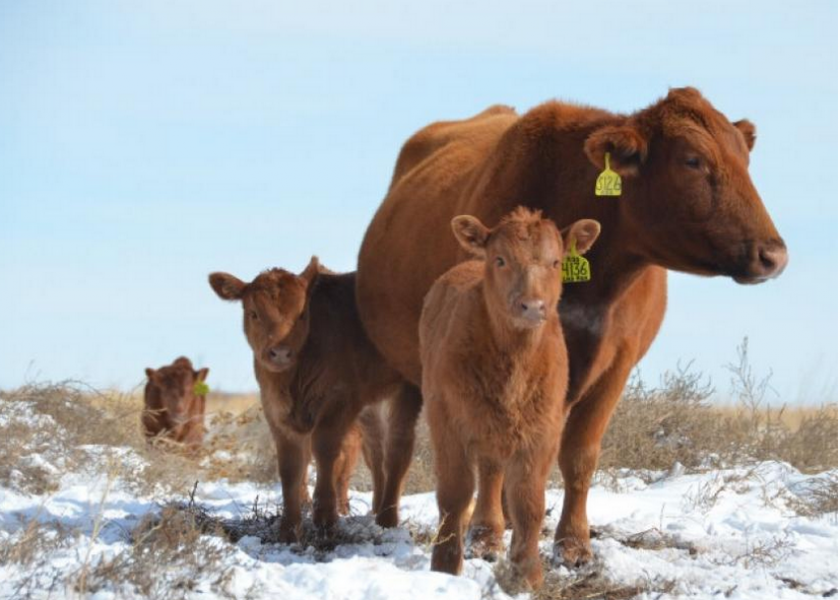Colder Temperatures and Calf Care Considerations

While it's only mid-October, colder temperatures will soon be here and have the greatest potential to cause serious problems in young calves, particularly calves in the first day of life. Because calves are born wet, have thin skin and very little body fat, they lose body heat very rapidly and if they are not able to become dry, can quickly become severely cold stressed. Contact with snow or wet ground will increase the amount of time that a calf stays wet and in danger. Body temperature of newborn calves can drop to dangerously low levels in 3 hours or less.
Calves are born with a body temperature of about 100˚F. When exposed to a cold environment, calves are able to produce heat in two ways, shivering and the heat production of brown fat (fat that surrounds the kidneys of a new-born) and they can conserve heat by reducing blood flow to the body surface and extremities (feet, ears, etc.). In early stages of cold exposure, calves will shiver vigorously and have a fast heart rate and breathing rate. If that does not keep the body temperature up, the calf’s body sends less blood to feet, ears, and nose in an effort to minimize heat loss.
Severe cold stress occurs when the calf's body temperature drops below 94˚F. At this temperature, the brain and other organs are affected and the calf becomes depressed, unable to rise, unwilling to suckle, and will temporarily lose the ability to shiver. The good news is that if the calf can be warmed-up and its body temperature can begin to rise, the shivering response will return and the core body temperature will slowly increase.
During periods of cold or wet weather, newborn calves (less than 1 to 2 days of age) should be checked every few hours with a thermometer and any calf with a below-normal temperature, even if it appears OK, should be warmed. Calves suffering from cold stress must be warmed so that body temperature can rise above 100˚F.
If body temperature has not dropped too far, putting the calf in the cab of a pickup out of the wind and rain or snow will warm the calf. In more severe cases the calves can be placed in warm water, specially designed warming boxes, or near a heat source such as an electric blanket, heat lamp, or hot water bottles. To avoid skin burns, the heat source should not exceed 108˚F. In addition to an external heat source, cold-stressed calves should be fed warm colostrum, milk, or electrolyte fluid with an energy source using an esophageal feeder.
Prevention of cold stress involves management to ensure that calves can be born in a short period of time and both the calf and dam can stand shortly after calving so that they can bond and the calf can begin suckling. Anything that prolongs calving or reduces the chance that a calf will suckle soon after birth should be addressed by management changes. Calving difficulties are minimized by proper heifer development, proper bull selection for calving ease, and proper nutrition so that heifers and cows calve in a body condition score of 5 to 6 on a 9-point scale. Cows with large teats or that are not attentive mothers should be culled.
Use of pasture as the primary forage source during calving encourages cows to keep spread apart and minimizes development of muddy areas. If the herd forage plan includes feeding hay, consider feeding hay in early to mid-gestation and saving stockpiled pasture for the calving season. If supplemental hay and grain are fed during calving, these should be provided at locations that are separate and distant from water sources and windbreaks.
I discourage the use of bale rings in calving and nursery pastures and suggest that if using large round bales, they be unrolled and the feeding area changed with each feeding. Unrolled bales will have greater hay waste, but reduced chance for mud caused by concentrating the herd into small feeding areas, and unrolled hay provides bedding for newborn calves so that they are not in direct contact with the ground.
In addition to monitoring the weather forecast for severe winter weather events and to be alerted to times when additional feed is needed, minimizing the effects of cold temperatures on newborn calves involves planning ahead and considering calf comfort and protection when making heifer development, bull selection, nutrition, and pasture management decisions. Making sure that cows will have adequate access to forage and water even in situations with significant snow cover is necessary to provide sufficient calories to maintain body fat and heat production. And, protecting the cowherd (and bulls) from winter wind and providing bedding if on concrete or mud/dirt will minimize the effects of severe weather.







